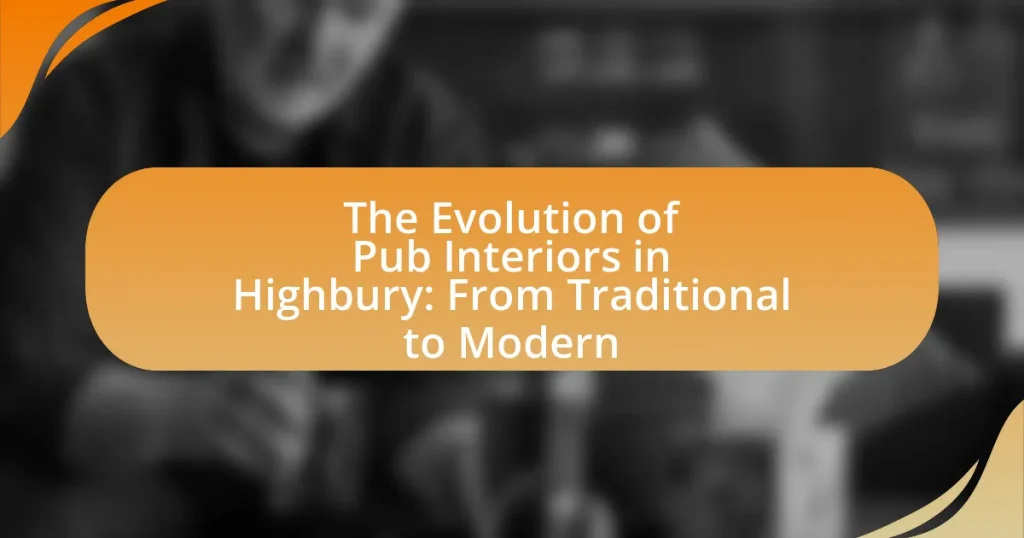The article examines the evolution of pub interiors in Highbury, highlighting the transition from traditional to modern designs. It outlines key characteristics of traditional pubs, such as warm atmospheres, historical architectural styles, and community-focused layouts, while also discussing how historical influences shaped these designs. The article further explores modern trends, including the use of contemporary materials, technology integration, and the shift in consumer preferences towards multifunctional spaces. Additionally, it addresses the challenges traditional pubs face in adapting to modern trends and offers strategies for maintaining their heritage while attracting a younger audience. Overall, the piece provides a comprehensive overview of how pub interiors reflect broader societal changes and cultural trends in Highbury.

What are the key characteristics of traditional pub interiors in Highbury?
Traditional pub interiors in Highbury are characterized by warm, inviting atmospheres, often featuring wooden beams, dark wood furnishings, and cozy nooks. These elements create a sense of comfort and community, which is essential to the pub experience. Additionally, traditional pubs typically showcase decorative features such as stained glass windows, vintage signage, and a central bar area that serves as a focal point for social interaction. The use of muted colors and soft lighting further enhances the welcoming ambiance, making these spaces ideal for relaxation and conversation. Historical context supports this design, as many of these pubs have retained their original architectural features, reflecting the area’s rich heritage and commitment to preserving traditional values in hospitality.
How did historical influences shape traditional pub designs?
Historical influences significantly shaped traditional pub designs by integrating architectural styles and social customs from various eras. For instance, the medieval period introduced timber framing and thatched roofs, which became characteristic features of English pubs. The Victorian era further transformed pub interiors with ornate detailing, stained glass, and the introduction of separate rooms for different social classes, reflecting the societal norms of the time. Additionally, the Industrial Revolution led to the establishment of larger pubs to accommodate the growing urban population, influencing layout and design to prioritize functionality and accessibility. These historical elements collectively created a unique aesthetic and social environment that defines traditional pub architecture today.
What architectural styles are prevalent in traditional pubs?
Traditional pubs predominantly feature architectural styles such as Tudor, Victorian, and Georgian. The Tudor style is characterized by its half-timbered construction and steeply pitched roofs, reflecting the medieval period. Victorian pubs often showcase ornate detailing, large windows, and intricate brickwork, which became popular during the 19th century as urbanization increased. Georgian architecture, known for its symmetry and proportion, typically includes features like sash windows and decorative cornices, representing the elegance of the 18th century. These styles not only define the aesthetic of traditional pubs but also reflect the historical context and social functions they served within their communities.
How do furnishings and decor reflect the traditional pub atmosphere?
Furnishings and decor reflect the traditional pub atmosphere through the use of warm wood tones, comfortable seating, and historical artifacts. Traditional pubs often feature dark wooden beams, sturdy tables, and upholstered chairs that create an inviting and cozy environment. The presence of vintage signage, framed photographs, and local memorabilia enhances the sense of community and nostalgia, reinforcing the pub’s role as a social hub. Additionally, the use of dim lighting and decorative elements like brass fixtures contributes to a relaxed ambiance, which is characteristic of traditional pubs. These design choices not only evoke a sense of history but also encourage patrons to linger and socialize, embodying the essence of the traditional pub experience.
What role did community and social interaction play in traditional pubs?
Community and social interaction were central to the function of traditional pubs, serving as vital spaces for local gatherings and relationship-building. Traditional pubs acted as communal hubs where individuals from the same neighborhood could connect, share stories, and foster a sense of belonging. Historical records indicate that pubs often hosted events such as quiz nights, live music, and community meetings, reinforcing their role as social centers. This interaction not only strengthened local ties but also contributed to the cultural identity of the area, as evidenced by the long-standing tradition of pubs being integral to community life in places like Highbury.
How did the layout of traditional pubs facilitate social gatherings?
The layout of traditional pubs facilitated social gatherings by incorporating communal spaces, such as large tables and open seating areas, which encouraged interaction among patrons. These designs often included features like a central bar, where customers could congregate, fostering a sense of community. Historical evidence shows that traditional pubs were designed with the intent to serve as social hubs, with layouts that prioritized accessibility and visibility, allowing for easy conversation and engagement among guests. This arrangement not only supported socialization but also contributed to the establishment of local networks and friendships, reinforcing the pub’s role as a vital social institution in the community.
What types of events were commonly hosted in traditional pubs?
Traditional pubs commonly hosted events such as quiz nights, live music performances, and community gatherings. These events served as social hubs, fostering community interaction and entertainment. For instance, quiz nights became popular in the 1970s, encouraging patrons to engage in friendly competition while enjoying drinks. Live music, often featuring local bands, provided entertainment and attracted diverse crowds, enhancing the pub’s role as a cultural venue. Community gatherings, including charity events and holiday celebrations, further solidified the pub’s status as a central meeting place in local neighborhoods.

How have modern influences transformed pub interiors in Highbury?
Modern influences have transformed pub interiors in Highbury by incorporating contemporary design elements, open layouts, and a focus on comfort and aesthetics. These changes reflect a shift from traditional, dark wood interiors to brighter, more inviting spaces that often feature minimalist decor, industrial materials, and multifunctional areas. For instance, many pubs now include cozy seating arrangements, vibrant color schemes, and artwork that resonates with local culture, enhancing the overall customer experience and attracting a diverse clientele. This evolution aligns with broader trends in urban design, where social spaces prioritize both functionality and visual appeal.
What are the defining features of modern pub interiors?
Modern pub interiors are characterized by a blend of contemporary design elements, open layouts, and a focus on comfort and social interaction. These interiors often feature industrial materials such as exposed brick, metal fixtures, and reclaimed wood, which create a rustic yet modern aesthetic. Additionally, modern pubs prioritize flexible seating arrangements, incorporating communal tables and cozy nooks to encourage socializing. The use of natural light is also a defining feature, with large windows and open spaces enhancing the atmosphere. Furthermore, modern technology, such as digital menus and integrated sound systems, is commonly integrated to improve customer experience. These elements reflect a shift from traditional pub designs, aligning with contemporary lifestyle preferences and social dynamics.
How do contemporary design trends differ from traditional styles?
Contemporary design trends differ from traditional styles primarily in their emphasis on minimalism, functionality, and the use of modern materials. While traditional styles often feature ornate details, rich textures, and historical references, contemporary design prioritizes clean lines, open spaces, and a more casual aesthetic. For instance, contemporary pubs in Highbury may utilize industrial materials like metal and glass, contrasting with the wood and brick commonly found in traditional pubs. This shift reflects broader societal changes, such as the move towards more informal social spaces and the integration of technology in design, which are less prevalent in traditional styles.
What materials and technologies are commonly used in modern pubs?
Modern pubs commonly utilize materials such as wood, metal, glass, and stone, alongside technologies like digital point-of-sale systems, smart lighting, and advanced sound systems. Wood is often used for furniture and flooring due to its aesthetic appeal and durability, while metal and glass are frequently incorporated in fixtures and decor for a contemporary look. Digital point-of-sale systems streamline transactions and improve customer service efficiency, with studies indicating that such systems can reduce wait times by up to 30%. Smart lighting enhances ambiance and energy efficiency, and advanced sound systems provide high-quality audio for entertainment, contributing to an engaging atmosphere.
Why have consumer preferences shifted towards modern pub experiences?
Consumer preferences have shifted towards modern pub experiences due to a desire for enhanced social interaction and a more diverse range of offerings. Modern pubs often feature open layouts, contemporary decor, and technology integration, which create inviting environments for socializing. According to a 2021 survey by the British Beer and Pub Association, 70% of patrons prefer venues that provide a mix of food, drink, and entertainment options, reflecting a trend towards multifunctional spaces. Additionally, the rise of craft beer and artisanal food has led consumers to seek out establishments that prioritize quality and unique experiences, further driving the shift towards modern pub concepts.
How do modern pubs cater to diverse clientele compared to traditional pubs?
Modern pubs cater to diverse clientele by offering a variety of environments, menus, and activities that appeal to different demographics, unlike traditional pubs which typically focused on a singular atmosphere and limited offerings. For instance, modern pubs often feature flexible seating arrangements, outdoor spaces, and themed nights that attract families, young professionals, and tourists, while traditional pubs generally maintained a more uniform and less adaptable setting. Additionally, modern establishments frequently provide extensive drink selections, including craft beers and non-alcoholic options, as well as diverse food menus that cater to various dietary preferences, such as vegetarian and gluten-free choices. This adaptability is supported by industry trends indicating that 70% of consumers prefer venues that offer a range of experiences, highlighting the shift in pub culture towards inclusivity and variety.
What impact has the rise of craft beer and artisanal offerings had on pub design?
The rise of craft beer and artisanal offerings has significantly influenced pub design by prioritizing unique, inviting spaces that enhance the customer experience. Pubs have shifted from traditional layouts to more open, flexible designs that accommodate social interaction and showcase a diverse range of beverages. This transformation often includes features like exposed brick, reclaimed wood, and industrial elements, reflecting the authenticity and craftsmanship associated with craft brewing. Additionally, many pubs now incorporate tasting rooms or dedicated areas for craft beer flights, allowing patrons to explore various styles in a comfortable setting. This evolution aligns with the growing consumer demand for personalized experiences and quality products, as evidenced by the increase in craft breweries, which reached over 8,000 in the United States by 2021, according to the Brewers Association.
What are the implications of the evolution of pub interiors for Highbury’s culture?
The evolution of pub interiors in Highbury significantly influences the local culture by reflecting changing social dynamics and community values. As traditional pubs transition to modern designs, they often incorporate elements that promote inclusivity and social interaction, such as open layouts and diverse seating arrangements. This shift not only attracts a broader demographic, including younger patrons and families, but also fosters a sense of community by encouraging gatherings and events. Furthermore, the integration of contemporary aesthetics and technology in pub interiors aligns with Highbury’s overall urban development, enhancing the area’s appeal and cultural vibrancy. This transformation illustrates how physical spaces can shape social experiences and community identity in Highbury.
How does the transformation of pub interiors reflect broader societal changes?
The transformation of pub interiors reflects broader societal changes by showcasing shifts in social norms, consumer preferences, and cultural values. For instance, the move from traditional, dark wood interiors to lighter, more open spaces indicates a societal trend towards inclusivity and community engagement, aligning with the rise of socializing in public spaces. Additionally, the incorporation of technology, such as digital menus and entertainment systems, mirrors the increasing integration of technology in daily life, highlighting a shift towards convenience and modernity. Historical data shows that during economic booms, pubs often undergo renovations to attract a younger demographic, while during downturns, they may revert to more traditional aesthetics, reflecting economic conditions and consumer behavior.
What cultural trends are influencing the design of pubs in Highbury?
Cultural trends influencing the design of pubs in Highbury include a shift towards sustainability, community engagement, and a focus on experiential dining. The emphasis on sustainability is evident in the use of reclaimed materials and eco-friendly practices, reflecting a growing consumer preference for environmentally responsible establishments. Community engagement is fostered through designs that encourage social interaction, such as open layouts and communal seating, catering to the local population’s desire for a sense of belonging. Additionally, the trend towards experiential dining incorporates elements like craft cocktails and gourmet food offerings, aligning with the increasing demand for unique and memorable experiences in social settings. These trends collectively shape the modern pub landscape in Highbury, moving away from traditional designs towards more contemporary, inclusive, and environmentally conscious spaces.
How do modern pubs contribute to the local community compared to traditional pubs?
Modern pubs contribute to the local community by offering diverse social spaces, events, and inclusive environments that cater to a wider demographic compared to traditional pubs. Unlike traditional pubs, which often focus on serving alcohol in a more limited social setting, modern pubs frequently host community events, live music, and themed nights, fostering engagement among residents. For instance, a study by the British Beer and Pub Association in 2021 highlighted that modern pubs are increasingly seen as community hubs, with 70% of respondents indicating they participate in local events hosted by these establishments. This shift not only enhances social cohesion but also supports local businesses through collaborations and partnerships, demonstrating a significant evolution in the role of pubs within their communities.
What challenges do traditional pubs face in adapting to modern trends?
Traditional pubs face significant challenges in adapting to modern trends, primarily due to their established identities and customer expectations. These establishments often struggle to balance the preservation of their historical charm with the need for contemporary amenities and design elements that attract a younger demographic. For instance, many traditional pubs have limited space and outdated layouts, making it difficult to incorporate modern features such as craft beer selections, technology for ordering, or social media engagement strategies. Additionally, the rise of competition from trendy bars and restaurants that offer unique experiences further pressures traditional pubs to innovate while maintaining their core values. According to a report by the British Beer and Pub Association, 60% of pubs have reported a decline in foot traffic due to changing consumer preferences, highlighting the urgency for traditional pubs to evolve in order to survive.
How can traditional pubs innovate while preserving their heritage?
Traditional pubs can innovate while preserving their heritage by integrating modern technology and contemporary design elements that complement their historical features. For instance, implementing digital ordering systems can enhance customer experience without altering the pub’s traditional ambiance. Additionally, incorporating sustainable practices, such as locally sourced ingredients and eco-friendly materials, allows pubs to modernize their operations while honoring their roots. Historical pubs often feature unique architectural elements; maintaining these while updating furnishings or introducing themed events can attract a diverse clientele. Evidence of this approach can be seen in pubs that have successfully blended modern craft beer offerings with traditional cask ales, appealing to both new and loyal customers.
What strategies can be employed to attract a younger audience to traditional pubs?
To attract a younger audience to traditional pubs, implementing modernized interior designs and offering diverse entertainment options are effective strategies. Modernized interiors can include vibrant colors, comfortable seating, and technology integration, which appeal to younger patrons who seek a more inviting atmosphere. Additionally, incorporating entertainment such as live music, trivia nights, and themed events can engage younger audiences, as studies show that 70% of millennials prefer venues that offer unique experiences. Furthermore, promoting social media engagement and creating shareable moments within the pub can enhance visibility and attract a younger demographic, as 54% of young adults are influenced by social media when choosing where to socialize.
What best practices can be adopted for designing a successful pub interior in Highbury?
To design a successful pub interior in Highbury, it is essential to create a welcoming atmosphere that reflects the local culture and community. Incorporating elements such as comfortable seating, warm lighting, and a cohesive color palette enhances the overall experience for patrons. Research indicates that spaces with varied seating arrangements encourage social interaction, which is vital for pubs. Additionally, integrating local artwork and historical references can foster a sense of place, making the pub more appealing to both residents and visitors. Effective use of space, including designated areas for dining and socializing, contributes to a functional layout that accommodates different customer needs.
How can a balance be achieved between traditional charm and modern functionality?
A balance between traditional charm and modern functionality can be achieved by integrating classic design elements with contemporary materials and technology. For instance, retaining original architectural features such as exposed beams or vintage furnishings while incorporating modern amenities like energy-efficient lighting and smart technology creates a harmonious environment. Research indicates that spaces that blend historical aesthetics with modern conveniences enhance user experience and satisfaction, as seen in successful pub renovations in Highbury that maintain their heritage while appealing to contemporary patrons.
What role does customer feedback play in the evolution of pub interiors?
Customer feedback plays a crucial role in the evolution of pub interiors by directly influencing design choices and renovations. Pubs often rely on customer insights to identify preferences for ambiance, layout, and amenities, which can lead to significant changes in interior design. For instance, a survey conducted by the British Institute of Innkeeping found that 70% of pub owners reported making alterations based on customer suggestions, such as incorporating more comfortable seating or enhancing lighting. This responsiveness to feedback not only improves customer satisfaction but also helps pubs stay competitive in a changing market, reflecting the evolving tastes and expectations of patrons.



